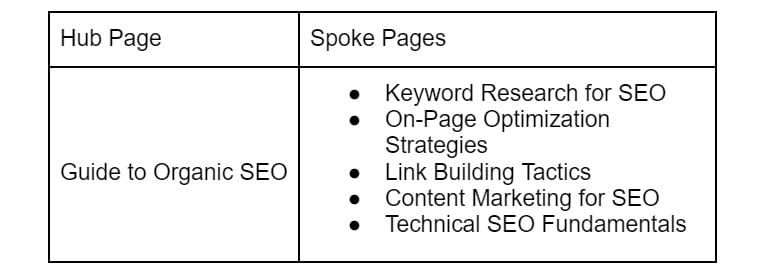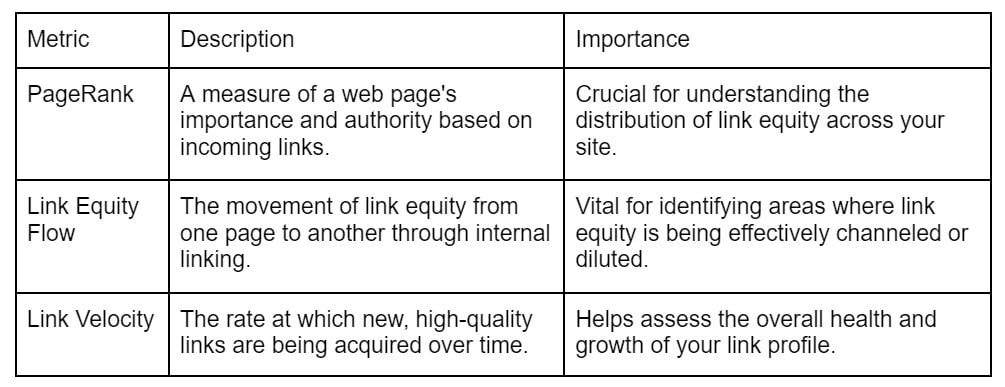Every page on your website plays a role in establishing authority and relevance. While homepages often receive the lion’s share of attention and external backlinks, inner pages are critical for creating a balanced and effective link equity distribution strategy. Building backlinks to these inner pages ensures they contribute to overall site authority, amplifying your topical relevance. These pages not only support the user journey but also serve as key hubs that drive topical relevance and authority across your site.
It shows that focusing solely on your homepage is not enough. In this article, I’ll explore the strategic nuances of link equity management. We’ll discuss techniques to maximize your website’s search engine optimization (SEO) potential.
Key Takeaways
- Link equity or the value and authority passed from one page to another through internal and external links, is a crucial factor in SEO.
- The distribution of link equity between a website’s homepage and its inner pages can significantly impact overall search rankings and performance.
- Identifying and optimizing high-value inner pages is essential for building a robust link architecture and enhancing a website’s authority.
- Implementing effective link sculpting techniques can help you direct link equity flow to maximize the impact on your most important pages.
- Regularly monitoring and adjusting your link equity distribution is crucial for maintaining a competitive edge in search engine results.
Understanding Link Equity and Its Impact on SEO
SEO is complex, and link equity is key to your site’s success. At its core, link equity is about PageRank, a search engine metric. It measures a page’s value based on inbound links’ quality and quantity.
The Role of PageRank in Link Distribution
PageRank was created by Google’s founders, Larry Page and Sergey Brin. It assesses a page’s importance by looking at inbound links. A higher PageRank means more link equity, boosting your site’s search rankings and visibility.
How Search Engines Interpret Link Value
Google and other search engines use complex algorithms to evaluate link value. They consider the linking page’s relevance, anchor text, and the linking website’s authority. Knowing these factors helps you optimize your link profile for better PageRank flow and link equity.
Key Factors Affecting Link Equity Flow
- Relevance of the linking page and website
- Diversity and quality of inbound links
- Anchor text used in the linking text
- Placement of the link on the page
- Avoidance of link equity dilution through strategic internal link optimization
Understanding link equity can significantly improve your website’s SEO. By focusing on pagerank flow, link equity dilution, and internal link optimization, you can enhance your site’s performance and visibility.
The Strategic Importance of Homepage Link Building
The homepage is key in external link building and link distribution strategy. It acts as the main entrance to your website, crucial for spreading link equity. A well-thought-out approach to homepage link building can significantly boost your SEO performance.
Homepages, being the most authoritative and visible, are ideal for external link building. High-quality backlinks to your homepage can enhance your site’s domain authority. This, in turn, improves your ranking in search engine results.
- Homepages often have the strongest link profile, acting as a funnel for link equity distribution.
- Directing external link building efforts towards the homepage can maximize the impact of your link distribution strategy.
- Leveraging the homepage’s authority can help strengthen the ranking of other important pages within your website.
Yet, it’s vital to balance homepage link building with diversifying your link distribution strategy to include inner pages. While the homepage is central, ensuring link equity reaches key inner pages is essential. Utilizing a link building tool can significantly aid in achieving a balanced and effective SEO approach. This creates a well-rounded SEO strategy.
Understanding the strategic value of homepage link building is crucial. By integrating it into your link distribution strategy, you can maximize your website’s SEO potential. This drives more targeted traffic to your most valuable content.
Inner Page Optimization: Beyond the Homepage
In the quest for internal link optimization, it’s essential to extend efforts beyond the homepage. Inner pages are crucial for spreading topical relevance and boosting your site’s overall link equity.
Identifying High-Value Inner Pages
Start by pinpointing your website’s most valuable inner pages. These are the ones that attract the most engagement, traffic, and conversions. By pinpointing these high-performers, you can direct link equity to enhance their influence. This makes them authoritative centers within your site’s content network.
Content-Driven Link Distribution
- Use your content strategy to create organic, contextually relevant links between inner pages.
- Place links in your content to guide users and search engines to your most valuable content.
- Make sure the anchor text in these links supports the topical relevance of the destination pages.
Converting Inner Pages into Authority Hubs
Through a well-thought-out internal link optimization strategy, you can turn your key inner pages into authority hubs. These pages will not only receive a steady flow of link equity. They will also distribute it to other relevant parts of your website, creating a unified and potent network of content.
The secret to successful inner page optimization is finding the right balance. It’s about building links on your homepage and strategically distributing link equity across your site. This comprehensive strategy will ensure your entire online presence is optimized for maximum visibility and authority in search engine’s eyes.
Implementing Effective Link Architecture
Optimizing your website’s link equity hinges on a well-designed link architecture. This approach ensures balanced link value distribution and boosts user experience. Key concepts include silo architecture and link sculpting techniques.
Silo architecture organizes content into distinct, interconnected “silos.” Each silo groups related pages, with a clear hierarchy and internal linking. This structure makes your site more intuitive and SEO-friendly, directing link equity to your homepage and inner pages effectively.
Link sculpting techniques complement silo architecture, refining link equity flow. They involve strategic internal linking, PageRank control, and link hierarchy enhancement. Mastering these techniques ensures your top pages get the link juice they need, preventing dilution and maximizing link-building impact.
- Establish a well-structured silo architecture to organize your website’s content.
- Implement link sculpting techniques to fine-tune the distribution of link equity.
- Ensure that your homepage and inner pages receive the appropriate level of link value.
- Continuously analyze and refine your link architecture to adapt to evolving search engine algorithms.
Adopting these strategies unlocks your website’s link architecture potential. It drives increased visibility, authority, and better search engine rankings.
Balancing Link Equity Across Your Website
Optimizing link equity distribution is key to effective SEO. Understanding link equity flow patterns and avoiding common mistakes is vital. This ensures your homepage and inner pages get the right search engine attention.
Distribution Patterns for Maximum Impact
Strategic link distribution is crucial for maximum impact. Focus on key inner pages and create a cohesive link architecture. This reinforces your content’s importance. A well-planned link distribution strategy can enhance your homepage’s authority, boosting your most valuable pages’ visibility.
Avoiding Common Link Dilution Mistakes
- Excessive external linking: Avoid linking to external sites without caution, as it can cause link equity dilution and weaken your site’s strength.
- Neglecting inner page optimization: Don’t overlook optimizing inner pages while focusing on the homepage. A lopsided link profile can miss your content’s full potential.
- Overlooking content relevance: It’s essential to ensure your content and links are topically relevant. This maintains a cohesive and impactful link distribution strategy.
Avoid these common pitfalls and implement a strategic link distribution strategy. This will help you achieve the right link equity balance. It amplifies your website’s visibility and authority in search engine results.
Advanced Link Sculpting Techniques
As an experienced SEO professional, I grasp the significance of refining link equity distribution across a website. The basics of link building and internal linking are essential, yet advanced link sculpting techniques can elevate your website’s optimization. We will explore strategies for managing PageRank flow and enhancing the impact of your link equity efforts.
Strategic nofollow implementation is a powerful technique. By applying the nofollow attribute to specific links, you can shape the flow of PageRank. This directs it towards your most valuable pages. It’s particularly useful for managing the link equity of your homepage versus inner pages, ensuring your key content hubs receive the necessary authority boost.
- Leverage canonical tags to consolidate link equity and prevent dilution.
- Employ redirection strategies to funnel link value towards target pages.
- Utilize HTML attributes like “sponsored” and “UGC” to manage the perceived quality of links.
- Optimize internal linking structures to strategically distribute link equity across your site.
By mastering these advanced link sculpting techniques, you can refine your website’s link architecture. This ensures your PageRank flow aligns with your SEO strategy. Such control and optimization can significantly impact your efforts to build a strong, authoritative online presence.

By integrating these advanced link sculpting techniques into your SEO strategy, you can manage your website’s PageRank flow. This ensures your most valuable pages receive the attention they deserve. As with any SEO best practice, it’s vital to monitor your results and adjust as needed to maintain optimal link equity distribution across your digital landscape.
Creating a Hub-and-Spoke Model for Link Distribution
Effective link distribution is key to maximizing link equity flow across your website. The hub-and-spoke model has become increasingly popular. It organizes content and internal links around a central “hub” page. Supporting “spoke” pages then radiate outward, connecting to the hub.
Designing Content Clusters
The hub-and-spoke model’s foundation is content clusters. These are groups of related pages centered around a topic or keyword. The hub page acts as the central authority, offering a comprehensive overview and linking to the spoke pages. These pages delve into subtopics or specific aspects of the main theme.
This structure ensures efficient link equity distribution. The hub page receives most inbound links, while spoke pages benefit from their association. This model boosts topical relevance and strengthens the hub-and-spoke model of your website’s link architecture.
Implementing Topical Relevance
- Identify core topical areas and establish clear content hierarchies within each.
- Designate hub pages as central authorities for each topic, offering a robust overview and internal linking structure.
- Develop spoke pages that delve deeper into specific subtopics, maintaining a thematic connection to the hub page.
- Ensure all content within a cluster is closely related and mutually reinforcing, enhancing the topical relevance of the hub-and-spoke model.
By adopting the hub-and-spoke model and focusing on topical relevance, you can craft a cohesive link distribution strategy. This strategy maximizes link equity flow across your website. It supports your SEO efforts and enhances user experience.

Measuring and Monitoring Link Equity Distribution
Keeping a balanced link equity distribution is vital for modern SEO. It’s crucial to track how link equity flows across your site. This ensures your internal linking strategy is effective.
Tracking PageRank on your homepage and inner pages is key. PageRank shows a page’s importance and authority based on incoming links. Monitoring PageRank helps spot where link equity is well-distributed or where it’s stuck.

Regularly reviewing your internal linking structure is also essential. You should strengthen connections between key pages, optimize anchor text, and ensure link equity supports your content and marketing goals.
By monitoring link equity and internal link optimization, you can make informed decisions. This helps maintain a balanced link architecture. It drives better search visibility and user engagement for your site.
Internal Linking Best Practices for 2025
Search engine algorithms are constantly evolving, making it essential to stay updated on internal linking strategies. In 2025, successful websites will adopt modern link structure approaches and use advanced tools for analysis and optimization. These best practices ensure your internal linking supports a balanced distribution of link equity across your site.
Modern Approaches to Link Structure
The outdated static, linear link structures are no longer relevant. Today, leading websites embrace dynamic, flexible internal linking methods. This includes contextual links and content clusters that foster strong relationships between related pages. Adopting these modern techniques enhances user experience and optimizes link equity flow.
Tools for Link Analysis and Optimization
Effective internal linking management requires the right tools for analysis and optimization. Google Search Console, Ahrefs, and Screaming Frog offer valuable insights into your site’s link profile. They help identify improvement opportunities, detect bottlenecks, and refine your internal linking structure. Utilizing these tools ensures your website’s link equity supports your SEO goals.
FAQ
What is link equity, and why is it important for SEO?
Link equity, also known as link juice or PageRank is the value a webpage gains from quality links. It’s vital for SEO because search engines use it to gauge a site’s relevance and importance. This can significantly affect its search rankings.
How do search engines interpret the value of a link?
Search engines, like Google, evaluate link value based on several factors. These include the authority of the linking site, content relevance, anchor text, and link placement. Links from authoritative, relevant sites carry more weight than those from low-quality sources.
What are the key factors that affect the flow of link equity?
Several factors influence link equity flow. These include a website’s overall link profile, internal link distribution, presence of nofollow or disavowed links, and link sculpting techniques. Managing these factors is crucial for optimizing link equity flow.
Why is homepage link building important for SEO?
The homepage is crucial as it’s the main entry point and central hub. Building high-quality links to it helps concentrate link equity. This can then be distributed to other pages, improving overall search rankings.
How can I identify and optimize high-value inner pages for link equity distribution?
To find high-value inner pages, analyze content relevance, user engagement, and link profiles. Strategically link these pages from the homepage and other authoritative sections. This helps distribute link equity and turns them into hubs that drive traffic and strengthen the site structure.
What are some effective link architecture models for balancing link equity?
Effective models include the silo structure and the hub-and-spoke model. The silo structure organizes content into clusters with strong internal links. The hub-and-spoke model has a central hub page that links to supporting content. Both models optimize link equity flow.
How can I avoid common link equity dilution mistakes?
Avoid diluting link equity by avoiding excessive external linking, poor internal link distribution, and using nofollow links without a strategy. Regularly audit your link profile and make strategic adjustments to maintain optimal link equity flow.
What are some advanced link sculpting techniques for fine-tuning link equity distribution?
Advanced techniques include using canonical tags, robots.txt files, and nofollow attributes to control PageRank flow. These require a deep understanding of search engine algorithms and should be used with caution to avoid negative effects.
How can I measure and monitor the effectiveness of my link equity distribution strategy?
Track PageRank, internal link ratios, and referring domain counts for your homepage and inner pages. Tools like Google Search Console, Ahrefs, and Semrush offer insights into your link profile, helping identify optimization areas.
What are some of the latest best practices for internal linking in 2024?
In 2024, best practices include using contextual, relevance-based links and implementing topic clusters and content hubs. Optimize anchor text and leverage tools for internal link analysis to strengthen strategic linking opportunities.



